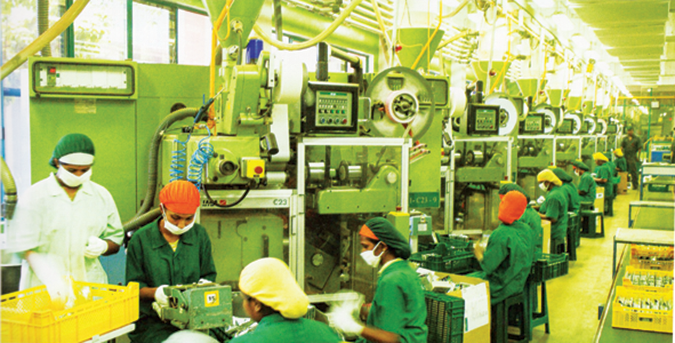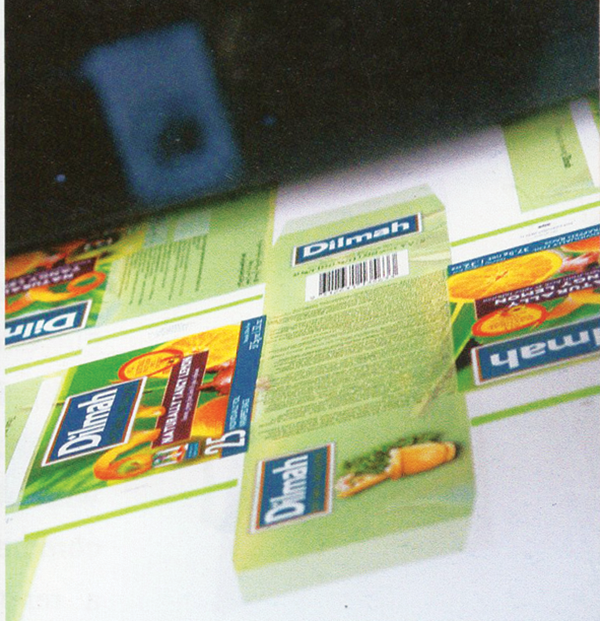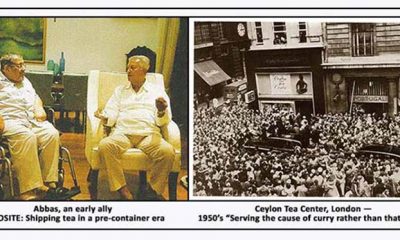Features
Setting up support services for the Dilmah brand

(Excerpted from the autobiography of Merrill J. Fernando)
In the development of my brand Dilmah, what has always been in public view is the brand and the publicity it garners, but not the behind-the-scenes toil, which has contributed to its development over the years. Some of our other successful ventures have also been overshadowed by the Dilmah brilliance. A few such ventures merit mention.
IMA Machines
To project Dilmah into the larger marketing chains, it had to be sold in tea bag form. Such production machines were very expensive, but with this in mind I visited a renowned tea bagging machine manufacturer, IMA, of Italy, a world leader in the design and manufacture of automatic machines for processing and packaging various products, ranging from pharmaceuticals and cosmetics to tea and coffee.
I met its founder, Dr. Andrea Romagnoli, and explained my vision. He agreed to sell me two machines at a special price, but also warned me that I may be many years ahead of the right opportunity for the optimum deployment of the machines. I bought two IMA-C21 machines from him and, visiting him a couple of times a year, also became good friends.
In Italy I also had a very reliable bulk tea agent, Giancarlo Beraldi, ably assisted by his dynamic wife, Edy, who displayed an insatiable curiosity about tea. They supplied bulk tea to the largest companies in Italy and, eventually, I became the major supplier of bulk tea from Ceylon to Italy. The Beraldis were a warm and generous couple who entertained me in the best restaurants in Milan, inculcating in me a lasting love for genuine Italian food.
The two IMA machines arrived and were installed in my Peliyagoda packing plant. However, in ominous confirmation of Dr. Romagnoli’s predictions, they were idle for quite some time. I did not lose heart though, despite a very expensive investment being inactive. I secured its agency in Sri Lanka, as well as the agencies for tea bag filter paper and other related components from J. R. Crompton.
I incorporated a separate company, Package Care Ltd., to market these products. All these initiatives were aspects of my vision for making value addition to tea in Sri Lanka, a realistic prospect for other exporters as well, providing them with a one-stop-shop for the purchase of the required finished material. It would save the potential exporter of value-added tea, the serious inconveniences I experienced in sourcing my requirements from Japan, the UK, and other countries.
About two years after my purchase of the machines, at the first IMA distributors’ conference in Milan, I was invited to speak on the first day. I used the opportunity to share with the participants my vision of value addition at origin and the benefits that would accrue to tea growers and workers as a result. Many found it interesting, challenging, and attractive, but none offered hope for its realization. The UK distributor was scornful, calling me a dreamer!
Printcare
Before I installed my first tea bag machines, I was importing tea bags and envelopes from Japan, a very costly and time-consuming exercise, as shipments often took as long as three months to arrive and if there was a common defect in the printing, the re-order took another three months.
I had just moved into my new office at Alston Place, Colpetty and I would personally go to Ranco Printers, also in close proximity, to get my visiting cards and other stationery printed. It was during this period that I met young K. R. Ravindran, whose grandfather, R. A. Nadesan, I already knew.
Ravindran one day visited me at my Gower Street home and in discussion came up with an interesting proposal. He was aware that I had ventured into the production of tea bags. His suggestion was that together we set up a business to produce tea bags and envelopes. Apparently, he had previously approached both Brooke Bond and lies Finlay, but clearly not envisaging the potential, neither had showed any serious interest in such a project.
I recognized the strategic importance of such a venture immediately. Indeed, it had been in my mind as well. Ravi had a very good understanding of the technical aspects of the printing business and, therefore, I promptly agreed to his proposal. Moving on, in 1979, we established a Joint Venture and named it ‘Printcare’. The name appealed to me as I had already incorporated ‘Package Care’ to deal with another aspect of my export operations.
Previously, the world over, tea bags and envelopes were printed using the ‘gravure’ process. We installed the first ‘Flexo’ process machine, an American machine from St. Louis called Mark Andy, to produce the material at the Peliyagoda premises. It was a business risk which soon paid dividends.
That was the beginning of one of the most successful printing and packaging businesses in the region. Together, Printcare and Package Care have made Dilmah completely self-sufficient in printing and packaging material requirements, whilst the two have also become preferred suppliers to the tea value-addition industry.
One major reason for the success of Printcare is that, having recognized in Ravindran a man with the same passion as I for excellence, I let him run that business entirely on his own judgment, with absolutely no interference from me. A small operation which commenced in a little garage-sized space with three people is today a renowned company with over 700 employees, with multiple manufacturing facilities here and in India and is, arguably, the world’s leading provider of tea bag tags and labels, supplying the largest tea companies in the world, including Lipton (initially), Tetley, and Twinings.
In a relatively short time the company acquired a life and an identity of its own and is now listed in the Colombo stock market. It has also expanded into other fields, providing printing solutions for the apparel, beverages, packaging, publishing, and security printing industries. It is also rated as one of the top export brands in the country.
One of the key lessons I learnt in my career, painfully and at considerable personal cost, is the importance of being in complete control of vital resources, men, material, and money. Dependence on others for crucially- important inputs is an ever-present risk, as individuals and institutions not directly in your business are not reliable all the time. An independent supplier of key components can hold the entrepreneur to ransom. In a fast-moving, export-oriented, value-addition operation, the key components must be available at hand for the timely delivery of the product to the customer.
Apart from the fact that I have always been ready to follow my instinct, if I perceive merit in an investment opportunity, I have never been hesitant about backing myself. I had to set in place the infrastructure that was essential for the business success of Dilmah. I have been very fortunate much of the time but, as I say repeatedly, in my success I also sense the hand of God.
In this writing I have described, in detail, the multinationals’ approach to business and the intimidatory strategies and tactics they unapologetically implement in the face of real or perceived threats to their interests. My connection with Printcare offers another very illustrative example.
As mentioned, Printcare was, for many years, a supplier to Lipton. In fact, Lipton encouraged and assisted Printcare to diversify its product portfolio, fostering a mutually-beneficial business relationship which lasted for many years; that is, till the intervention of the Brussels-based Paul Eavers, Unilever Global Supply Manager, Packaging, In May 2000 he advised Printcare that Unilever was concerned about my relationship with Printcare and, therefore, it had been decided to terminate the business with a supplier with links to a competitor.
The numerous appeals and counter arguments to this decision offered by Printcare were of no avail. In the course of the next few months Lipton withdrew from all business dealings with Printcare, causing considerable loss to the latter as it had made substantial investments to cater to the Lipton business, which were, quite naturally, on the assumption of a long-term relationship. Given the volume of its business with Lipton, it took Princare quite some time and effort to restore volumes and income to previous levels, without the Lipton contribution.
Timber concepts
From the very inception of the tea industry and up to the late ’80s, the extensive use of timber has been an adverse undesirable feature of its operations. Millions of trees would have been felled in order to make all the crates in which tea used to be packed. The switch to paper sacks made a difference in that recycling became possible and the use of timber has decreased.
However, wooden boxes are still used in packing and dispatching special types of tea, particularly to the Middle East, where fancy and elaborate presentations, carrying tea from one to five kg, are still much sought after. It is a small, niche industry but with much potential, which I decided to move into one day.
I purchased the wood working machinery on a visit to Taiwan and waited for the right operations chief in a competitive woodworking business. I told him to join me when he decided that he needed to quit his present job and, some months later, he met me again. I was prepared to let him invest part of his savings and to set him up in the business, but both Dilhan and Himendra, my Deputy Chairman, talked me out of it.
Subsequently, we set up a business in a large warehouse built for me in Hendala, by R&T Constructions and called it Timber Concepts and got it going. Today it is a thriving business with regular export orders. I persuaded Sirimevan, the Manager, to invest in the company at Rs. 10 per share up to 15% and over that at Rs. 25 per share. I have found that often, even those closest to me, do not share my confidence in new ventures.
Ceylon Tea Services
In 1982, two investment consultants prevailed on me to take Ceylon Tea Services Ltd. public. At that time the business was progressing well and there was no urgent need to inject funds from outside. Initially I was reluctant but Chandi Chanmugam, then Secretary to the Treasury, with whom I discussed the matter sometime in 1983, was very encouraging and offered me special incentives to do so. His point was that it would be a unique opportunity for me, as Sri Lanka, though being a major tea producer, did not have a single publicly-listed tea company.
Chanmugam was a man I had much respect for and his arguments persuaded me to go ahead. I offered 20% of the company at Rs. 10 per share and, to my surprise and pleasure, within seven hours, the offer was fully subscribed. The bankers to the issue was Overseas Trust Bank, of which the Managing Director, Yeshwant Desai, was a close family friend. I purchased some of the shares myself.
For anybody who subscribed to that share issue, it would have been a gilt-edged investment, as the current value of a share is Rs. 550. That is apart from the annual earnings per share in the way of dividends and bonus shares as well.
Features
The heart-friendly health minister

by Dr Gotabhya Ranasinghe
Senior Consultant Cardiologist
National Hospital Sri Lanka
When we sought a meeting with Hon Dr. Ramesh Pathirana, Minister of Health, he graciously cleared his busy schedule to accommodate us. Renowned for his attentive listening and deep understanding, Minister Pathirana is dedicated to advancing the health sector. His openness and transparency exemplify the qualities of an exemplary politician and minister.
Dr. Palitha Mahipala, the current Health Secretary, demonstrates both commendable enthusiasm and unwavering support. This combination of attributes makes him a highly compatible colleague for the esteemed Minister of Health.
Our discussion centered on a project that has been in the works for the past 30 years, one that no other minister had managed to advance.
Minister Pathirana, however, recognized the project’s significance and its potential to revolutionize care for heart patients.
The project involves the construction of a state-of-the-art facility at the premises of the National Hospital Colombo. The project’s location within the premises of the National Hospital underscores its importance and relevance to the healthcare infrastructure of the nation.
This facility will include a cardiology building and a tertiary care center, equipped with the latest technology to handle and treat all types of heart-related conditions and surgeries.
Securing funding was a major milestone for this initiative. Minister Pathirana successfully obtained approval for a $40 billion loan from the Asian Development Bank. With the funding in place, the foundation stone is scheduled to be laid in September this year, and construction will begin in January 2025.
This project guarantees a consistent and uninterrupted supply of stents and related medications for heart patients. As a result, patients will have timely access to essential medical supplies during their treatment and recovery. By securing these critical resources, the project aims to enhance patient outcomes, minimize treatment delays, and maintain the highest standards of cardiac care.
Upon its fruition, this monumental building will serve as a beacon of hope and healing, symbolizing the unwavering dedication to improving patient outcomes and fostering a healthier society.We anticipate a future marked by significant progress and positive outcomes in Sri Lanka’s cardiovascular treatment landscape within the foreseeable timeframe.
Features
A LOVING TRIBUTE TO JESUIT FR. ALOYSIUS PIERIS ON HIS 90th BIRTHDAY

by Fr. Emmanuel Fernando, OMI
Jesuit Fr. Aloysius Pieris (affectionately called Fr. Aloy) celebrated his 90th birthday on April 9, 2024 and I, as the editor of our Oblate Journal, THE MISSIONARY OBLATE had gone to press by that time. Immediately I decided to publish an article, appreciating the untiring selfless services he continues to offer for inter-Faith dialogue, the renewal of the Catholic Church, his concern for the poor and the suffering Sri Lankan masses and to me, the present writer.
It was in 1988, when I was appointed Director of the Oblate Scholastics at Ampitiya by the then Oblate Provincial Fr. Anselm Silva, that I came to know Fr. Aloy more closely. Knowing well his expertise in matters spiritual, theological, Indological and pastoral, and with the collaborative spirit of my companion-formators, our Oblate Scholastics were sent to Tulana, the Research and Encounter Centre, Kelaniya, of which he is the Founder-Director, for ‘exposure-programmes’ on matters spiritual, biblical, theological and pastoral. Some of these dimensions according to my view and that of my companion-formators, were not available at the National Seminary, Ampitiya.
Ever since that time, our Oblate formators/ accompaniers at the Oblate Scholasticate, Ampitiya , have continued to send our Oblate Scholastics to Tulana Centre for deepening their insights and convictions regarding matters needed to serve the people in today’s context. Fr. Aloy also had tried very enthusiastically with the Oblate team headed by Frs. Oswald Firth and Clement Waidyasekara to begin a Theologate, directed by the Religious Congregations in Sri Lanka, for the contextual formation/ accompaniment of their members. It should very well be a desired goal of the Leaders / Provincials of the Religious Congregations.
Besides being a formator/accompanier at the Oblate Scholasticate, I was entrusted also with the task of editing and publishing our Oblate journal, ‘The Missionary Oblate’. To maintain the quality of the journal I continue to depend on Fr. Aloy for his thought-provoking and stimulating articles on Biblical Spirituality, Biblical Theology and Ecclesiology. I am very grateful to him for his generous assistance. Of late, his writings on renewal of the Church, initiated by Pope St. John XX111 and continued by Pope Francis through the Synodal path, published in our Oblate journal, enable our readers to focus their attention also on the needed renewal in the Catholic Church in Sri Lanka. Fr. Aloy appreciated very much the Synodal path adopted by the Jesuit Pope Francis for the renewal of the Church, rooted very much on prayerful discernment. In my Religious and presbyteral life, Fr.Aloy continues to be my spiritual animator / guide and ongoing formator / acccompanier.
Fr. Aloysius Pieris, BA Hons (Lond), LPh (SHC, India), STL (PFT, Naples), PhD (SLU/VC), ThD (Tilburg), D.Ltt (KU), has been one of the eminent Asian theologians well recognized internationally and one who has lectured and held visiting chairs in many universities both in the West and in the East. Many members of Religious Congregations from Asian countries have benefited from his lectures and guidance in the East Asian Pastoral Institute (EAPI) in Manila, Philippines. He had been a Theologian consulted by the Federation of Asian Bishops’ Conferences for many years. During his professorship at the Gregorian University in Rome, he was called to be a member of a special group of advisers on other religions consulted by Pope Paul VI.
Fr. Aloy is the author of more than 30 books and well over 500 Research Papers. Some of his books and articles have been translated and published in several countries. Among those books, one can find the following: 1) The Genesis of an Asian Theology of Liberation (An Autobiographical Excursus on the Art of Theologising in Asia, 2) An Asian Theology of Liberation, 3) Providential Timeliness of Vatican 11 (a long-overdue halt to a scandalous millennium, 4) Give Vatican 11 a chance, 5) Leadership in the Church, 6) Relishing our faith in working for justice (Themes for study and discussion), 7) A Message meant mainly, not exclusively for Jesuits (Background information necessary for helping Francis renew the Church), 8) Lent in Lanka (Reflections and Resolutions, 9) Love meets wisdom (A Christian Experience of Buddhism, 10) Fire and Water 11) God’s Reign for God’s poor, 12) Our Unhiddden Agenda (How we Jesuits work, pray and form our men). He is also the Editor of two journals, Vagdevi, Journal of Religious Reflection and Dialogue, New Series.
Fr. Aloy has a BA in Pali and Sanskrit from the University of London and a Ph.D in Buddhist Philosophy from the University of Sri Lankan, Vidyodaya Campus. On Nov. 23, 2019, he was awarded the prestigious honorary Doctorate of Literature (D.Litt) by the Chancellor of the University of Kelaniya, the Most Venerable Welamitiyawe Dharmakirthi Sri Kusala Dhamma Thera.
Fr. Aloy continues to be a promoter of Gospel values and virtues. Justice as a constitutive dimension of love and social concern for the downtrodden masses are very much noted in his life and work. He had very much appreciated the commitment of the late Fr. Joseph (Joe) Fernando, the National Director of the Social and Economic Centre (SEDEC) for the poor.
In Sri Lanka, a few religious Congregations – the Good Shepherd Sisters, the Christian Brothers, the Marist Brothers and the Oblates – have invited him to animate their members especially during their Provincial Congresses, Chapters and International Conferences. The mainline Christian Churches also have sought his advice and followed his seminars. I, for one, regret very much, that the Sri Lankan authorities of the Catholic Church –today’s Hierarchy—- have not sought Fr.
Aloy’s expertise for the renewal of the Catholic Church in Sri Lanka and thus have not benefited from the immense store of wisdom and insight that he can offer to our local Church while the Sri Lankan bishops who governed the Catholic church in the immediate aftermath of the Second Vatican Council (Edmund Fernando OMI, Anthony de Saram, Leo Nanayakkara OSB, Frank Marcus Fernando, Paul Perera,) visited him and consulted him on many matters. Among the Tamil Bishops, Bishop Rayappu Joseph was keeping close contact with him and Bishop J. Deogupillai hosted him and his team visiting him after the horrible Black July massacre of Tamils.
Features
A fairy tale, success or debacle

Sri Lanka-Singapore Free Trade Agreement
By Gomi Senadhira
senadhiragomi@gmail.com
“You might tell fairy tales, but the progress of a country cannot be achieved through such narratives. A country cannot be developed by making false promises. The country moved backward because of the electoral promises made by political parties throughout time. We have witnessed that the ultimate result of this is the country becoming bankrupt. Unfortunately, many segments of the population have not come to realize this yet.” – President Ranil Wickremesinghe, 2024 Budget speech
Any Sri Lankan would agree with the above words of President Wickremesinghe on the false promises our politicians and officials make and the fairy tales they narrate which bankrupted this country. So, to understand this, let’s look at one such fairy tale with lots of false promises; Ranil Wickremesinghe’s greatest achievement in the area of international trade and investment promotion during the Yahapalana period, Sri Lanka-Singapore Free Trade Agreement (SLSFTA).
It is appropriate and timely to do it now as Finance Minister Wickremesinghe has just presented to parliament a bill on the National Policy on Economic Transformation which includes the establishment of an Office for International Trade and the Sri Lanka Institute of Economics and International Trade.
Was SLSFTA a “Cleverly negotiated Free Trade Agreement” as stated by the (former) Minister of Development Strategies and International Trade Malik Samarawickrama during the Parliamentary Debate on the SLSFTA in July 2018, or a colossal blunder covered up with lies, false promises, and fairy tales? After SLSFTA was signed there were a number of fairy tales published on this agreement by the Ministry of Development Strategies and International, Institute of Policy Studies, and others.
However, for this article, I would like to limit my comments to the speech by Minister Samarawickrama during the Parliamentary Debate, and the two most important areas in the agreement which were covered up with lies, fairy tales, and false promises, namely: revenue loss for Sri Lanka and Investment from Singapore. On the other important area, “Waste products dumping” I do not want to comment here as I have written extensively on the issue.
1. The revenue loss
During the Parliamentary Debate in July 2018, Minister Samarawickrama stated “…. let me reiterate that this FTA with Singapore has been very cleverly negotiated by us…. The liberalisation programme under this FTA has been carefully designed to have the least impact on domestic industry and revenue collection. We have included all revenue sensitive items in the negative list of items which will not be subject to removal of tariff. Therefore, 97.8% revenue from Customs duty is protected. Our tariff liberalisation will take place over a period of 12-15 years! In fact, the revenue earned through tariffs on goods imported from Singapore last year was Rs. 35 billion.
The revenue loss for over the next 15 years due to the FTA is only Rs. 733 million– which when annualised, on average, is just Rs. 51 million. That is just 0.14% per year! So anyone who claims the Singapore FTA causes revenue loss to the Government cannot do basic arithmetic! Mr. Speaker, in conclusion, I call on my fellow members of this House – don’t mislead the public with baseless criticism that is not grounded in facts. Don’t look at petty politics and use these issues for your own political survival.”
I was surprised to read the minister’s speech because an article published in January 2018 in “The Straits Times“, based on information released by the Singaporean Negotiators stated, “…. With the FTA, tariff savings for Singapore exports are estimated to hit $10 million annually“.
As the annual tariff savings (that is the revenue loss for Sri Lanka) calculated by the Singaporean Negotiators, Singaporean $ 10 million (Sri Lankan rupees 1,200 million in 2018) was way above the rupees’ 733 million revenue loss for 15 years estimated by the Sri Lankan negotiators, it was clear to any observer that one of the parties to the agreement had not done the basic arithmetic!
Six years later, according to a report published by “The Morning” newspaper, speaking at the Committee on Public Finance (COPF) on 7th May 2024, Mr Samarawickrama’s chief trade negotiator K.J. Weerasinghehad had admitted “…. that forecasted revenue loss for the Government of Sri Lanka through the Singapore FTA is Rs. 450 million in 2023 and Rs. 1.3 billion in 2024.”
If these numbers are correct, as tariff liberalisation under the SLSFTA has just started, we will pass Rs 2 billion very soon. Then, the question is how Sri Lanka’s trade negotiators made such a colossal blunder. Didn’t they do their basic arithmetic? If they didn’t know how to do basic arithmetic they should have at least done their basic readings. For example, the headline of the article published in The Straits Times in January 2018 was “Singapore, Sri Lanka sign FTA, annual savings of $10m expected”.
Anyway, as Sri Lanka’s chief negotiator reiterated at the COPF meeting that “…. since 99% of the tariffs in Singapore have zero rates of duty, Sri Lanka has agreed on 80% tariff liberalisation over a period of 15 years while expecting Singapore investments to address the imbalance in trade,” let’s turn towards investment.
Investment from Singapore
In July 2018, speaking during the Parliamentary Debate on the FTA this is what Minister Malik Samarawickrama stated on investment from Singapore, “Already, thanks to this FTA, in just the past two-and-a-half months since the agreement came into effect we have received a proposal from Singapore for investment amounting to $ 14.8 billion in an oil refinery for export of petroleum products. In addition, we have proposals for a steel manufacturing plant for exports ($ 1 billion investment), flour milling plant ($ 50 million), sugar refinery ($ 200 million). This adds up to more than $ 16.05 billion in the pipeline on these projects alone.
And all of these projects will create thousands of more jobs for our people. In principle approval has already been granted by the BOI and the investors are awaiting the release of land the environmental approvals to commence the project.
I request the Opposition and those with vested interests to change their narrow-minded thinking and join us to develop our country. We must always look at what is best for the whole community, not just the few who may oppose. We owe it to our people to courageously take decisions that will change their lives for the better.”
According to the media report I quoted earlier, speaking at the Committee on Public Finance (COPF) Chief Negotiator Weerasinghe has admitted that Sri Lanka was not happy with overall Singapore investments that have come in the past few years in return for the trade liberalisation under the Singapore-Sri Lanka Free Trade Agreement. He has added that between 2021 and 2023 the total investment from Singapore had been around $162 million!
What happened to those projects worth $16 billion negotiated, thanks to the SLSFTA, in just the two-and-a-half months after the agreement came into effect and approved by the BOI? I do not know about the steel manufacturing plant for exports ($ 1 billion investment), flour milling plant ($ 50 million) and sugar refinery ($ 200 million).
However, story of the multibillion-dollar investment in the Petroleum Refinery unfolded in a manner that would qualify it as the best fairy tale with false promises presented by our politicians and the officials, prior to 2019 elections.
Though many Sri Lankans got to know, through the media which repeatedly highlighted a plethora of issues surrounding the project and the questionable credentials of the Singaporean investor, the construction work on the Mirrijiwela Oil Refinery along with the cement factory began on the24th of March 2019 with a bang and Minister Ranil Wickremesinghe and his ministers along with the foreign and local dignitaries laid the foundation stones.
That was few months before the 2019 Presidential elections. Inaugurating the construction work Prime Minister Ranil Wickremesinghe said the projects will create thousands of job opportunities in the area and surrounding districts.
The oil refinery, which was to be built over 200 acres of land, with the capacity to refine 200,000 barrels of crude oil per day, was to generate US$7 billion of exports and create 1,500 direct and 3,000 indirect jobs. The construction of the refinery was to be completed in 44 months. Four years later, in August 2023 the Cabinet of Ministers approved the proposal presented by President Ranil Wickremesinghe to cancel the agreement with the investors of the refinery as the project has not been implemented! Can they explain to the country how much money was wasted to produce that fairy tale?
It is obvious that the President, ministers, and officials had made huge blunders and had deliberately misled the public and the parliament on the revenue loss and potential investment from SLSFTA with fairy tales and false promises.
As the president himself said, a country cannot be developed by making false promises or with fairy tales and these false promises and fairy tales had bankrupted the country. “Unfortunately, many segments of the population have not come to realize this yet”.
(The writer, a specialist and an activist on trade and development issues . )


























